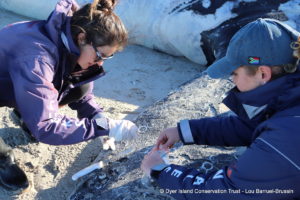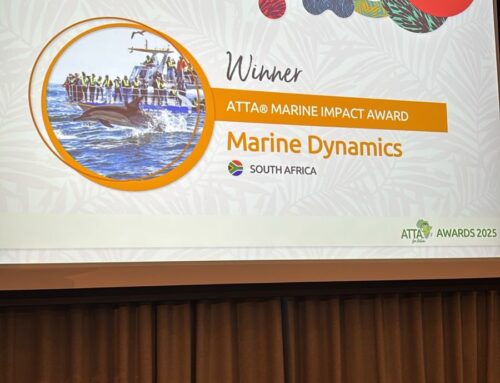On 22 June, the Dyer Island Conservation Trust and Marine Dynamics teams were alerted of a stranded Humpback whale along the beach at Die Dam. A resident of Die Dam, Johanna von Molendorff, sighted the whale, with alerts posted to local stranding pages too. Early the next morning, 23 June, our teams started the journey towards the area. The attendees were conservation biologist, Sandra Hörbst, marine biologist, Amy Webber, African Penguin and Seabird Sanctuary veterinarian, Anne-Marie Robberts, Marine Dynamics Academy intern, Lou Barruel-Brussin and Marine Dynamics CEO, Wilfred Chivell.

Once at Die Dam, Johanna joined our team to begin the 4×4 drive along the beach. Blue skies and a low tide made for the perfect conditions to access the whale, with the team arriving at the site after only a few minutes. As we pulled up next to the Humpback whale, it was clear to see that it had passed away a few days prior, positioned on its stomach. The skin was degraded and colouration was a pale grey, however, the distinctive dorsal positioned two-thirds down the length of the body and baleen plates made a species identification very clear.
Humpback whales have a global distribution, with southern hemisphere individuals travelling to the coast of South Africa between June and October during their migration from colder southern waters, showcasing one of the longest migrations of any mammal on our planet. Our waters provide refuge for these whales where they will breed and calf, with warmer temperatures offering more suitable conditions for younger individuals to gain strength and increase survival rates. Humpback whales form part of the baleen species, a filter-feeding group of whales. The baleen plates are situated on the upper jaw and allow water to be expelled from the mouth, trapping prey species such as small crustaceans and smaller bony fish.

After noting down the GPS location of the whale, our biologists, intern and veterinarian got busy with data collection. Photos of the whale were taken by Lou, including the entire length of the body as well as notable markings or external abrasions. Externally, there was no indication of the whale’s death, with the animal being in fairly good condition despite the skin degradation. Sandra and Amy collected physical samples from the animal, including skin, blubber, barnacles and baleen. A dislodged plate of baleen positioned off to the side of the stranding meant no extraction was needed, and also offered an impressive insight as to how these plates are held together within the animal’s mouth. The samples collected are provided to the UP Mammal Research Institute Whale Unit, established in 1985. Further testing will be completed on the samples, providing further biological insight into the species and large marine cetaceans.
Barnacles are a common “hitch-hiker” on whale species, attaching themselves to the skin of the whale. The barnacles gain access to consistent food sources and a stable living location but do so with no harm coming to the whale. This type of relationship is known as commensalism, with one whale having as many as 450kg worth of barnacles, a small fraction of their total body weight!

Once samples were successfully collected and packaged, it was time for measurements. Over 20 different measurements were noted, with the total length of the Humpback being recorded at 12.6m. The tail itself, called the fluke, was over 3.7m in width, indicating a more mature individual. The pattern beneath a Humpback whale fluke is used to identify specific individuals, each being unique to the whales, as a fingerprint would be to humans. Due to the belly-side position of the stranded animal, the sex was unable to be determined.

Once all the required data was collected, our team packed up and loaded into the vehicle. Maneuvering between the rocks along the beach, Wilfred and Johanna shared a conversation about the threats facing our marine life. With humpback whale numbers having recovered tremendously after near extinction due to whaling, it is still paramount we take the opportunities to better understand these charismatic whales, known for their powerful song and surface activity of breaches and fin slapping. A deeper understanding of their biology and migrations continuously empowers effective conservation, ensuring these animals, and those that share the environment, may never be threatened with extinction again.





